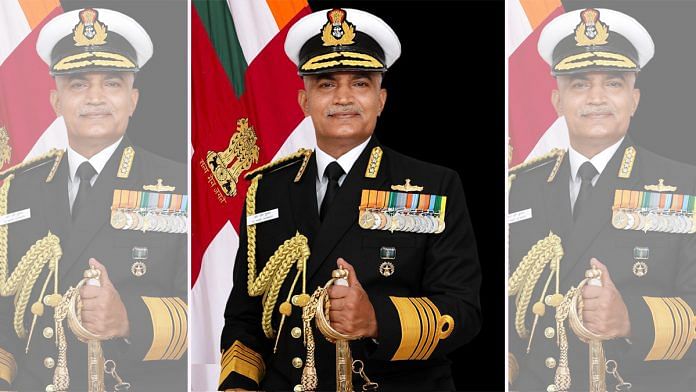New Delhi: Admiral R. Hari Kumar, a gunner specialist and an advocate of integrated theatre commands, Tuesday took over as the 25th Chief of the Naval Staff. He succeeds Admiral Karambir Singh, who retired from the service after a 30-month tenure as the Navy chief.
“It is a matter of great honour for me to take charge as the Chief of Naval Staff. Indian Navy’s focus is on our national maritime interests and challenges,” Admiral Kumar said as he received the Guard of Honour at the South Block in the national capital.
Admiral Kumar was earlier the Flag Officer Commanding-in-Chief Western Naval Command. Among the previous nine Navy chiefs, he is the fourth to have commanded INS Ranvir, a Rajput class guided missile destroyer. He has also commanded the aircraft carrier INS Viraat besides other surface vessels.
Born on 12 April 1962, the National Defence Academy graduate was commissioned into the Indian Navy on 1 January 1983. He is the first Navy chief to hail from Kerala.
His appointment comes at a time when the Navy is in the middle of a modernisation process amid a brewing challenge from China, which has the fastest-growing Navy in the world.
The new Navy chief is an ardent supporter of the planned integrated theatre commands. He played a pivotal role in drawing up the concept as the Chief of the Integrated Defence Staff.
Also read: China’s military hardware export to Pakistan will affect security dynamics, says Navy chief
Tasks before the new chief
According to Navy sources, the new chief’s main task will be to ensure that the pace of naval modernisation increases despite budgetary concerns.
The Navy has already scaled back its plans to be a 200-ship strong force amid constraints. It now plans a 170-ship force. Currently, 39 submarines and surface ships are under construction at various Indian shipyards, besides the two frigates being built for the Navy in Russia.
However, India has commissioned just one-two capital warships in each of the last five years — not enough to even replace the retiring warships.
This is in stark contrast with the Chinese pace of commissioning about 18-20 warships every year.
A US Defense Department report this month on China’s military capabilities noted that the People’s Liberation Army Navy has numerically the largest Navy in the world with an overall battle force of approximately 355 ships and submarines, including approximately over 145 major surface combatants, outnumbering even the Americans.
China is also set to launch its third aircraft carrier, which will have the catapult technology for take-off rather than the traditional ski-jump. This comes even as India debates whether to even have a third aircraft carrier. It is estimated that China may end up operating six aircraft carriers by 2030.
Admiral Kumar’s approach towards a third aircraft carrier that the Navy is strongly pushing for, will be closely monitored as the CDS and others within the defence establishment have instead called for turning the Andaman and Nicobar and Lakshadweep Islands into “unsinkable carriers”.
The new Navy chief will also have to steer the ‘Project 75 India’ to its fruition as the force aims to build six new conventional submarines with Air Independent Propulsion System.
Admiral Kumar, who has undergone courses at the Naval War College, US, Army War College, Mhow and Royal College of Defence Studies, UK, will also have to spearhead the plan to induct new helicopters for the naval fleet as well as new fighter aircraft. Both projects have been hanging in the balance for a long time.
His other big focus will be continuing with the Navy’s approach on interoperability with other navies of the world through joint bilateral and multilateral exercises.
Hug to mother, IIT ambitions
On Tuesday, the new Navy chief marked his takeover ceremony with a hug to his mother B. Vijayalakshmi at the South Block lawns.
Speaking to reporters at the event, the Admiral said he used to write letters to his mother every Friday during his NDA days to fulfill a promise to his father. He added that he didn’t nurture an ambition to join the Armed Forces during his school days. His aim was to secure an engineering seat at the IITs or any college back in Kerala.
“My maternal uncle Wing Commander S.K.J. Nair, my cousin Captain H. Muraleedharan of the Indian Army, and Major General R.P. Bhadran inspired me to join the force. They encouraged me to sit for the National Defence Academy entrance exam,” he told Manorama News.
(Edited by Amit Upadhyaya)
Also read: Navy chief commissions INS Vela, calls it ‘potent platform’ for spectrum of operations






